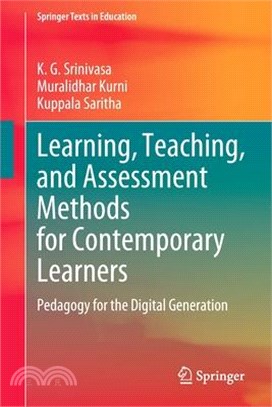Learning, Teaching, and Assessment Methods for Contemporary Learners: Pedagogy for the Digital Generation
商品資訊
ISBN13:9789811967337
出版社:Springer Nature
作者:K. G. Srinivasa
出版日:2022/11/23
裝訂:平裝
定價
:NT$ 6379 元若需訂購本書,請電洽客服 02-25006600[分機130、131]。
商品簡介
相關商品
商品簡介
Chapter 1. Introduction 1.1. What is Pedagogy? 1.2. Why Pedagogy is Important? 1.3. Different Types of Pedagogies 1.4. How is Pedagogy Changing? 1.5. How does pedagogy impact the learner? 1.6. Modern learning, teaching, and assessment methods 1.6.1. Crossover Learning 1.6.2. Learning Through Collaborative Argumentation 1.6.3. Incidental Learning 1.6.4. Context-Based Learning 1.6.5. Computational Thinking 1.6.6. Learning by Doing 1.6.7. Embodied Learning 1.6.8. Adaptive Teaching/Learning 1.6.9. Analytics of Emotions 1.6.10. Stealth AssessmentChapter 2. Crossover Learning 2.1. What is Crossover Learning? 2.2. Why is it good to implement? 2.3. Why is Crossover Learning Working in the Classroom? 2.4. How to implement it? 2.5. Limitations / Major Barriers and Disadvantages of adopting Crossover Learning 2.6. Case Studies
Chapter 3. Learning Through Collaborative Argumentation 3.1. What is Collaborative Argumentation? 3.2. Benefits of Argumentation 3.3. Techniques for Effective Collaborative Argumentation 3.4. Preparing Classroom Environments for Collaborative Argumentation 3.5. Case Studies
Chapter 4. Incidental Learning 4.1. What is Incidental Learning? 4.2. What is the Impact of Incidental Learning? 4.3. How to Engage with Incidental Teaching? 4.4. Incidental Learning in the Classroom 4.5. Incidental Learning and Intentional Learning 4.6. Informal and Intentional Learning 4.7. Case Studies
Chapter 5. Context-Based Learning 5.1. What is Context-Based Learning? 5.2. Why Context-Based Learning? 5.3. Context-Based Learning and Competence 5.4. Impact on Students' Learning 5.5. Creating Context-Based Learning Environments 5.6. Connecting Concepts and Contexts 5.7. Selection of Contexts 5.8. Assessment in context-based teaching and learning 5.9. Case Studies
Chapter 6. Computational Thinking 6.1. What is Computational Thinking? 6.2. Why Computational Thinking is important? 6.3. Key Skills for Computational thinking 6.4. Six Principles of Computational Thinking 6.5. Learning Strategies for Developing Computational Thinking Skills 6.6. Computational thinking in practice 6.7. Thinking computationally 6.8. Assessment of computational thinking 6.9. Case Studies
Chapter 7. Learning by Doing 7.1. What is Learning-by-doing? 7.2. Why Learning-by-doing is important? / Why is Learning-by-doing effective? 7.3. What We Learn When We Learn by Doing
Chapter 3. Learning Through Collaborative Argumentation 3.1. What is Collaborative Argumentation? 3.2. Benefits of Argumentation 3.3. Techniques for Effective Collaborative Argumentation 3.4. Preparing Classroom Environments for Collaborative Argumentation 3.5. Case Studies
Chapter 4. Incidental Learning 4.1. What is Incidental Learning? 4.2. What is the Impact of Incidental Learning? 4.3. How to Engage with Incidental Teaching? 4.4. Incidental Learning in the Classroom 4.5. Incidental Learning and Intentional Learning 4.6. Informal and Intentional Learning 4.7. Case Studies
Chapter 5. Context-Based Learning 5.1. What is Context-Based Learning? 5.2. Why Context-Based Learning? 5.3. Context-Based Learning and Competence 5.4. Impact on Students' Learning 5.5. Creating Context-Based Learning Environments 5.6. Connecting Concepts and Contexts 5.7. Selection of Contexts 5.8. Assessment in context-based teaching and learning 5.9. Case Studies
Chapter 6. Computational Thinking 6.1. What is Computational Thinking? 6.2. Why Computational Thinking is important? 6.3. Key Skills for Computational thinking 6.4. Six Principles of Computational Thinking 6.5. Learning Strategies for Developing Computational Thinking Skills 6.6. Computational thinking in practice 6.7. Thinking computationally 6.8. Assessment of computational thinking 6.9. Case Studies
Chapter 7. Learning by Doing 7.1. What is Learning-by-doing? 7.2. Why Learning-by-doing is important? / Why is Learning-by-doing effective? 7.3. What We Learn When We Learn by Doing
主題書展
更多
主題書展
更多書展今日66折
您曾經瀏覽過的商品
購物須知
外文書商品之書封,為出版社提供之樣本。實際出貨商品,以出版社所提供之現有版本為主。部份書籍,因出版社供應狀況特殊,匯率將依實際狀況做調整。
無庫存之商品,在您完成訂單程序之後,將以空運的方式為你下單調貨。為了縮短等待的時間,建議您將外文書與其他商品分開下單,以獲得最快的取貨速度,平均調貨時間為1~2個月。
為了保護您的權益,「三民網路書店」提供會員七日商品鑑賞期(收到商品為起始日)。
若要辦理退貨,請在商品鑑賞期內寄回,且商品必須是全新狀態與完整包裝(商品、附件、發票、隨貨贈品等)否則恕不接受退貨。
























